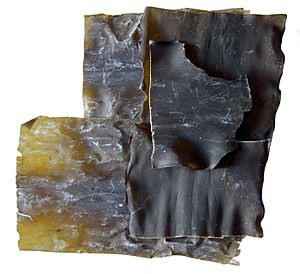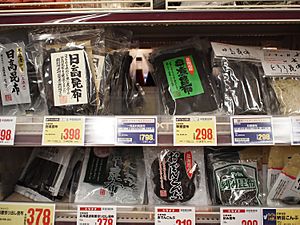Kombu facts for kids
Kombu is a type of edible seaweed, also known as kelp. It's very popular in East Asia, especially in Japan, Korea, and China. In Korea, it's called dasima, and in China, it's known as haidai.
People in many cultures eat kelp, but the Japanese have been eating it for over 1,500 years and use it a lot in their food.
Contents
Types of Kombu
There are about eighteen different kinds of edible kelp that are often called kombu. It can be a bit confusing because these types have different names in biology and in the fishing world. Here are some of the main types:
- Saccharina japonica (Ma-kombu)
- Saccharina japonica var. ochotensis (Rishiri-kombu) – This type is often used to make soup stocks.
- Saccharina latissima (Karafuto-kombu) – It tastes sweeter because it contains a natural sugar called mannitol.
- Saccharina angustata (Mitsuishi-kombu) – This one is commonly used to make dashi, a basic Japanese soup broth.
- Saccharina gyrata (Tororo-kombu)
What's in a Name?
The word "kombu" comes from the Japanese language.
Long ago in Japan, edible seaweed was simply called "me." Over time, specific types got their own names. Kombu was once known as hirome (meaning "wide") or ebisume. The names konfu and kofu started appearing in Japanese writings around the 12th and 13th centuries.
There are two main ideas about where the name "kombu" came from:
One idea is that it came from the Chinese name for a similar seaweed, 昆布 (kūnbù). This Chinese word has been around since at least the 3rd century.
Another idea is that the Chinese descriptions of kūnbù were not always clear, and it's hard to know exactly which seaweed they were talking about. For example, some old Chinese writings described kūnbù as growing in the South China Sea, but kombu doesn't grow there. Also, some Chinese texts even listed kūnbù and haidai (which is what they call kombu today) as different things.
A Brief History of Kombu
It's hard to find old evidence of seaweed because it breaks down easily. However, some remains of other seaweeds have been found from the Jōmon period (an ancient time in Japan), which suggests people might have eaten kombu back then too.
Written records show that kombu was important. In 797, people from the Emishi region (now part of northern Japan) offered kombu as a gift to the Japanese court every year.
During the Muromachi period (1336–1573), a new way to dry kombu was developed. This meant kombu could be stored for a long time, and it became an important product to sell from the northern Tohoku area. By the Edo period (1603–1868), as the island of Hokkaidō was settled and shipping routes improved, kombu became popular all over Japan.
Okinawa, a group of islands in southern Japan, uses a lot of kombu in its traditional food. This started in the Edo period, and today, families in Okinawa use more kombu than anywhere else in Japan. In the 20th century, people learned how to grow kombu, making it cheaper and easier for everyone to get.
The word "kombu" first appeared in an English book in 1867, in a Japanese and English dictionary.
In 1908, a Japanese scientist named Kikunae Ikeda discovered something amazing about kombu. He found that a special taste, which he called umami (meaning "delicious taste"), came from glutamic acid in kombu broth. This was a new basic taste, different from sweet, sour, bitter, and salty.
Since the 1960s, dried kombu has been sent from Japan to many countries. You can now find it in Asian food stores, supermarkets, and health food shops.
Cooking with Kombu
Kombu is sold in different forms. You can find it dried (called dashi konbu), pickled in vinegar (su konbu), or as dried shreds (oboro konbu or tororo konbu). Sometimes, it's even eaten fresh in sashimi dishes.
Kombu is a key ingredient in Japanese cuisine. It's one of the main things used to make dashi, a basic soup stock. To make konbu dashi, you put dried kombu (either whole or powdered) in cold water and heat it almost to boiling. The softened kombu can then be eaten or sliced and used to make tsukudani, a dish cooked in soy sauce and mirin (a sweet cooking wine).
Kombu can also be pickled with sweet and sour flavors, cut into small strips. These are often eaten as a snack with green tea. People sometimes add kombu when cooking beans, as it's thought to add nutrients and help digest the beans better.
Konbu-cha is a tea made by soaking kombu in hot water. (This is different from the fizzy drink called kombucha that is popular in Western countries).
Kombu is also used to prepare the seasoned rice for making sushi.
-
A dish of tsukudani made from kombu
-
Kombu in Oden (a Japanese stew)
-
Kobumaki (kombu roll). Often, fish like herring is rolled inside.
-
Nimono (a Japanese simmered dish) with kombu.
Kombu and Biofuel
Scientists have found a way to use special E. coli bacteria to turn kombu into ethanol. This means kombu could potentially become a source of biofuel from the ocean!
See also
 In Spanish: Kombu para niños
In Spanish: Kombu para niños







